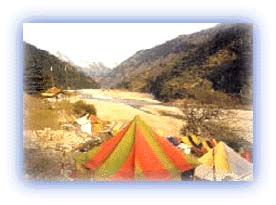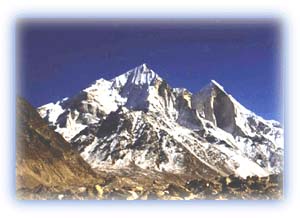Garhwal himalayas
General info
· Uttarakhand
· Eastern Garhwal
· Western Garhwal
· Sacred Ganga
· Gangotri
· Gaumukh
· Route to Gangotri
· Dharali
· Towards Gangotri
Wilson Saga
· Yamunotri
· Tons Valley
· Har-Ki-Dun Valley
· People
Other Places of Interest
· Uttarkashi
People
· Jaunsaries
· Jadhs
· Marchas
· Bhotias
Religion
· Gods and Goddesses
Flora and Fauna
· Wildlife

![]()
|
Harsil and the Wilson Saga Upstream, at a point where three mountain torrents merge into each other, is Harsil (or Hursil). This was once home to Raja Wilson, a legendary character in Garhwal. Mention his name, and stories still pour out about him. |
 |
| Tents at Harsil Credit: Discover India |
His real name was Frederick Wilson. A "native" of Lancashire, England, Wilson was attracted by the beauty of the mountains. In the beginning, he was content to wander in the upper reaches of the vast valleys of Uttarakhand. By the middle of the 19th century, Wilson had integrated perfectly with the locals, teaching them his own skills. Foremost amongst these was the introduction of potato cultivation. The tradition-plagued croppping patterns gave way to apple orchards and the hillsides began to turn pink in spring. The mountain folk too gave their love and trust in abundance to this man. Soon, derogatory labels of "deserter" or "wandering pauper" heaped upon him by the rest of the British Raj who could not accept his integrating with the locals gave way to the imperial title "Raja Wilson".
At Harsil, he settled down in what is now called 'Wilson Hut'. This "hut" is actually a magnificent bungalow. A harmonious blend of stone and wood, which is a permanent reminder of the freebooter F.E. Wilson, who married a local girl Gulabi and settled down.
He leased the forests of the region from the Raja of Tehri in 1859, for a period of five years. The lack of roads did little to deter him and he floated timber down the Ganga to fill the gap in providing sleepers for the railways. In a very short span of time, he made a huge fortune.
The old forest rest houses at Dharasu, Bhatwari and Harsil were his staging posts along the narrow trail that snaked its way from one village to the other.
Bridge building was another of Wilson's interests. One of these was meant to facilitate travel between Hursil and the holy shrine at Gangotri. The most famous of these was a 350 ft suspension bridge over the Jadhganga at the stupendous gorge of Bhaironghati -- over 1,200 ft off the valley floor. This shaky contraption was at first a source of great terror to the locals, and none would venture across. To reassure the hill folk, Wilson mounted his grey stallion and galloped to and fro across the planks. The original bridge no longer exists but people will tell you that the hoof beats of his horse can still be heard on full-moon nights.
Wilson's legend lives on and though no attempts have been made to glorify him, the residents still speak of him in awe and admiration, as if he had just passed by yesterday. Some men give their spirit to a place and become a part of its love and legend.
 |
| (left to right) Bhagirathi II (6512m), III (6454m), and I (6856m), from the West.The highest peak of the Bhagirathi Group forms a complex and topographically complicatedmassif. Bhagirathi Parbat has three major peaks. It stands at and dominates the end of the
valley leading up to Gaumukh which is the end of the Gangotri Glacier and the source of the river Ganga. The upper part of the river Ganga is also called Bhagirathi, and both the mountain and the river are named after King Bhagirath. This King is said to have forced the Goddess Ganga to descend from the heavens in the form of a raging torrent in response toBhagirath's 'intense and determined austerities'. Credit: Hugo Velthuijsen |
All rights reserved